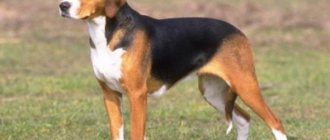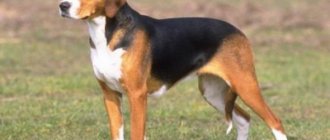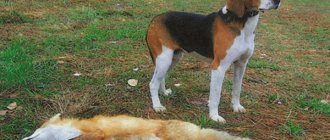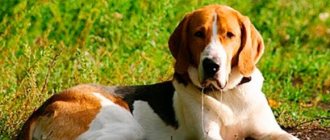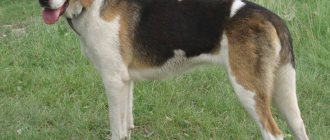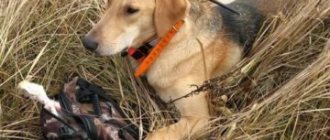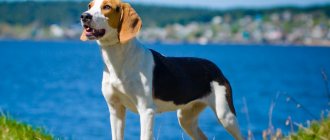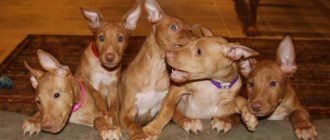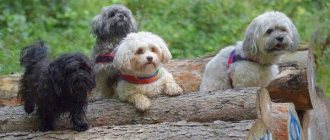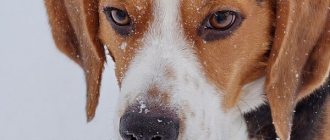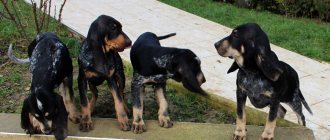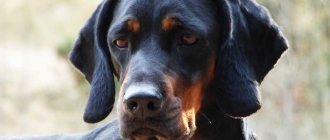Hunting was traditionally considered the favorite pastime of the Russian nobility, and hounds were the main characters in it.
Even then, the character traits and skills inherent in hunting breeds were valued.
Thus, for several centuries, the Russian hound has been considered the best hunting assistant and is dearly loved by Russian hunters .
The formation of a young catch
Hunters who have dogs will understand me, but those who don’t….
So. On the third of May this year, while hunting, I learned that my dog, a Russian hound, was born. And now, after a month and a half, I became the proud owner of this miracle
The feeling of holding a child in your hands is both scary and exciting at the same time... Who will grow it, how she will show herself, and, in the end, what to do with THIS lump. Everything that has been read and re-read dozens of times about upbringing, feeding and maintenance is out of your head. But gradually everything falls into place, and now you are feeding, walking and playing with your pet.
Five months exactly. The whole family is walking through the forest again, Mida and her daughter are frolicking in the forest clearings, playing tag... The forest is fragrant with aromas, I am breathing deeply watching the games, when suddenly Mida sticks her nose into the wet pine needles and immediately gives a voice, starting to move away from the road. Here she is already walking in a circle 100 meters from us, but it is clear that her movements are chaotic and more like throwing in agony. This is understandable, the puppy still does not understand what alarmed him so much, forcing him to bark against his own will... After laying 3 or 4 circles and apparently losing the scent trail, she continued playing with my daughter. Having carefully examined the place, I assumed that most likely the fox had left the mark, and this was already good.
Having received a cap from the breeder for his work on a roe deer, he again switched to searching for a hare and a fox, but until the opening of the winter season, we were never able to see any of them again. And time passed. And on the second of November, the first, I went to the opening with a friend and his young drathaar Iron, but I managed to trample only one fox, which, literally rising from under my feet, was successfully killed.
But still, resentment and disappointment cover me, and how could it be otherwise, Mida again did not scent the beast. I wander gloomily further, immersed in unhappy thoughts, when suddenly Mida’s voice echoes and a brief rush, apparently towards the fox. Yes, that’s how it is, the fox goes far away, and soon the dog loses its trace. The rain began in earnest, and without testing the maneuverability of our Cube, we returned home
The morning of November 9 was amazing! I went to bed in the rain and woke up in the winter. 30cm of snow in one night. It became clear that we would not see the hare, the rare long eared ear, wet in the rain and covered with snow, would leave its nook, unless, of course, a locomotive rumbled over its ear. The hunt did not take place.
November 18 began with a morning call from Mikhalych, the huntsman of the Pankrushikha district, who said that a voucher for roe deer had been received, and they were waiting for me on the evening of the 21st. I agreed only on the condition that they would give me the opportunity to work with the dog on hare, which is simply abysmal in Pankrushikha this year. Having received assurances that this would be the case, I began to wait for this happy moment.
Completely upset, I return to work, and late in the evening I set off for the 250 km that separated me from my cherished place. The dog and I passed this distance without incident and spent agonizing hours waiting for the Saturday dawn.
Sunday brought light snowfall from three in the morning to five in the morning. The mood is high, and it’s already dark before we reach the grounds. It was decided to devote the whole day to roe deer. They really dedicated the day, or rather spent it in ordeals around the land, but the goats were never found. True, along the way we got one hare and a couple of foxes, but Mida didn’t work on this already familiar animal either.
I was then admittedly in deep shock and sadness, despite the fact that my mouth was from ear to ear, but in my soul... MGLA - Mida is silent. But what can we do, we are returning home, because the thaw that began, out of the blue, was also enriched with fluffy snowfall. Slightly lost in this snowy dance, we circle around a tiny island of willow trees and discover that we have captured a bunny. There is still a little more than an hour of daylight left and we decide to chase this runner away for the last time. I have nothing to lose, and I again fall out of the “tablet”, agreeing on where my comrades will intercept the beast. Mida follows me. The car has moved far enough away and I decide to let the dog off the leash...
And then something happened that I didn’t expect at all...
There was no strength, and congratulations poured in all around. How could it be otherwise, the pupil sparkled after so much work and agonizing expectations. And I was convinced of this the following Saturday, when from near Mida, all in the same Pankrushikha, we got two birds with one stone.
I am the happiest hunter!
Source
About the constitution and exterior of hounds
Let’s take only one thing from theory: the external forms of hounds are closely related to their functions
Anyone who thinks that hound breeds in the Russian Empire were created only for hunting hares and foxes are deeply mistaken. From time immemorial we have been eaten by predators, especially wolves. This is happening now. Game scientists claim that wolves everywhere in Russia destroy the annual growth of ungulates. Russia ranks one of the last in the world in terms of the presence of ungulates. And this phenomenon has been going on for centuries. The main reason for this is wolves and poachers.
We are constantly engaged in the extermination of wolves in different ways, including aviation. And it is known from history that the most effective method is complete and rifle hunting for wolves with hounds, by the way, although expensive, it is less so than other hunts.
Our forefathers identified a group of dogs that are in constant struggle with their intraspecific enemy. They carried it on for centuries and realized that results can only be achieved by surpassing the enemy with physical strength. “The wolf is a big animal. The length of its body reaches one and a half meters. Weight – from 45 to 65 kg” (Yu.V. Bukatevich, “Gonchak”, p. 68).
Hence the question: in order to overwhelm this mass, what mass should the hound be?
This is where the “strong type of constitution” and the “bestial appearance” inherent only to it, reminiscent of a wolf, appeared in the standard of the Russian hound. It was then that some responsible “specialists” began to forge the standard to suit their hounds.
I admire the photograph of Bushuy 1050/01 Military A.A. in “ROG” No. 6 (602) and is upset by Gaidai 9537/88 Petrushina N.V., for which I apologize to the owner. In my understanding, this is not a Russian hound, which, perhaps, is good at chasing white hares. What if you meet a wolf in the forest? I ask this question for a reason. In the summer of 2005, I took my Rasdoya II, a hunting one (Sergeevsky), to the apiary and threw it into Malye Dubki early in the morning. Not even 5 minutes had passed when I heard a fight - a roar. I immediately realized that it was a fight with a wolf. The first thing that came into my hands was an ax. I run to help, fortunately, not far away. Standing, clinging to each other, the survivor and the pereyarok. There is a brutal beating going on. I made the mistake of running from the direction of Rasdoy, and the wolf, seeing me, rushed with incredible force and escaped from the grip of the survivor. Rasdoy with the voice behind him. Gon retreated towards the Big Oaks. At the scene of the fight I saw a lot of blood and thought: “Goodbye, Rasdoy!” I was surprised by the abundance of blood and the clear voice of the survivor during the rut. I think that if a wolf bit through the throat of a survivor, his voice would be hoarse. There was some hope.
And if anyone doesn’t know why wolves have a scruff and a thick undercoat, then I explain that among wolves not a single meal goes by without a fight, with an inherited blow to the most vulnerable place - the neck, so that individuals without a scruff and undercoat would long ago went to their ancestors.
I personally saw hounds snatched from wolves with their skins in tatters because they did not have undercoat, which, in my deep conviction, in both wolves and hounds is not only a temperature regulator, but also a shock absorber from blows from fangs.
Every year I take part in wolf hunts and every time I remind the hounds that look at the coat of the wolves, the hounds should have the same coat.
Based on considerations of the type of constitution and clothing of the hounds, what I saw in 2002 in Tambov gives reason to believe that the majority of hounds in both breeds did not meet the standards of these breeds. But there was also a minority there, which is what we need to focus on in breeding reproduction.
Regarding the general type of constitution of both breeds of our hounds, I would make a proposal for the growth of the hounds: make a change to the height at the withers of 65–70 cm, and for the hatchlings 60–65 cm, since by October the arrived wolves reach a height of 60 cm or more. In a pack fight, the role of the survivors will be involuntarily directed towards the seasoned ones, and the survivors should choke the newcomers. This is a dream, but I think it must be realized. Since it is necessary to measure both breeds by the wolf, and let the beagles, basset hounds and Estonian hounds chase the hares - this is their profile.
“Even in our largest Moscow ring, one can observe emerging disproportions in the composition.
Cutting and brutality. And the main thing is how the breeding type itself is being eroded in both breeds” - this is R.I. Shiyan, “Russian Hound”, pp. 138 ff “. the type, which was quite clearly outlined in the Russian Hound breed and had already become widespread in the 50s–70s, turned out to be largely confused.” Ibid., p.139. Who is against this?
Maliciousness - this hereditary predisposition to chase a predatory animal - was lost not as a result of the government banning wolf hunting with hounds, but through its non-encouragement and non-support of this hunt. It turned out to be financially beyond the reach of societies. They stopped measuring hounds by the wolf, being content with the hare and the fox.
Therefore, cowardice, a vice of the hound, was not slow to show itself in the Russian hound breed. Hounds M.Ya. Sergeev were basically evil. He explained this by heredity received from Spevaya Goryansky A.P. and its Fills. Spevai Goryansky, descended from the hounds of Musin-Pushkin, chased a bear alone in the Zasursky forests! Personally, he recommended that the cowardly hounds be sent to the aspen. I have been hunting with hounds for 70 years and I am convinced that what was said is correct. I don’t hold panties, I reject them harshly in the rings. I called myself a Russian hound - be a fighter - that’s my motto. But I don’t claim the absolute truth. To each his own.
N.A. is right Kuzyaev in one. There are basically two methods for assessing the exterior: visual assessment and measurement. Many, including outstanding experts, conduct their examination using the first method. In my practice I have never used the second one. And for the time being I had no complaints about the examination and assessment of the dogs.
But among dog breeders, especially those selling puppies, there were also extremists in the Anglo-Russian hound breed.
Everything about the Russian Hound dog breed
Hunting was traditionally considered the favorite pastime of the Russian nobility, and hounds were the main characters in it.
Even then, the character traits and skills inherent in hunting breeds were valued.
Thus, for several centuries, the Russian hound has been considered the best hunting assistant and is dearly loved by Russian hunters .
A brief excursion into the history of the breed
At the moment, it has not been possible to find out where these hounds came from in Russia. It is believed that their historical homeland is the Mongol-Tatar Khanate, and they came to us during the period of the yoke. That is why the breed is sometimes called the eastern hound.
Russian hound
The second theory is that the Russian hound dog was bred as a result of natural crossing of native huskies with pointers brought from the east. The formation of the breed phenotype was completed at the beginning of the 20th century, but the Civil War and the Second World War had a negative impact on the number of animals. The breed was endangered. In peacetime, it had to be revived almost from scratch.
Note! Now the hunting hound is widely popular, but the FCI is not recognized.
Description of the breed
A graceful, stately breed with royal manners and endless devotion to the owner and his work. Despite the fact that hounds are considered one of the oldest dog breeds that directly took an active part in human life, the first breed standard was developed only in 1824 . In those days, large landowners were engaged in breeding the breed. They raised dogs for themselves, for hunting, and chose the best representatives of the breed.
How to understand that a dog is ready to hunt
A dog's readiness to hunt is determined by the following criteria:
- ability to work in any conditions;
- development of all necessary skills;
- correct rutting style (with minimal chipping, sticky and rough, with a loud bark).
If everything is done correctly, then in 50 outings the dog can be prepared for hunting. However, do not despair if this is not successful: it means that the dog is not ready yet and the training should be repeated next year.
Training a hound is a long and labor-intensive process. But when your dog becomes a true hunter and even wins awards in field trials, you will realize that all the hard work has paid off in full. For a dog, hunting is work and pleasure, but for a person it is a favorite hobby.
Peculiarities
The breed is distinguished by its friendliness and responsiveness towards people, in contrast to its hunting anger towards game. The hound is always ready to serve its owner. Has charm and an excellent mind, allowing him to quickly find prey.
Knows no fear or fatigue, a pack of 4 hounds can chase wild boars or even a bear, using barking to transmit coordinates about the location of the game. The bark is loud and loud, scattering for many kilometers in the forest.
But you will feel best when fulfilling your direct duties, serving as a professional hunter. Dogs of this breed are social animals, but not obsessive. They have a balanced character and do not require increased attention to themselves.
In hound dog breeds, the sex of an individual is usually classified using the expression “vyzhlovka” or “vyzhlovka”. Girls, or rather vyzhlovkas, are considered more submissive and predictable. Boys of this breed, on the contrary, are too wayward.
Leave your comment
Only registered users can leave their reviews and comments. You can log in using your account on our website, as well as log in using your VKontakte or Facebook account.
Typo in title.
The author still should have separated the concepts of a bow and a pair of hounds.
a pair of hounds is just two dogs, a bow is two hounds working in pairs, equal in legs and skill. with respect Kozlov P.M.
As far as I understand, a bow is, first of all, a vyzhlovka and a vyzhlovka.
Once again I am convinced that Peter knows what he is writing about. The test rules interpret this term more broadly. “Two hounds of the same breed are considered a match.” There are no restrictions, only one requirement: catching up and working together. The term is not so clear-cut. On the other hand, a classic bow is, of course, a bow and a bow, selected according to color, height, even legs, and so on and so forth. As for the article, everything that was written here completely coincided with my own experience, with one exception, I did not succeed in making a real bow, but it was an attempt due to my youth.
Comparison with Russian pinto hound
There are absolutely no differences in hunting or physical characteristics between the Russian Hound and the Russian Pinto Hound. But it would also be incorrect to consider these two breeds as one.
According to the breed standard, the Russian Piebald Hound was bred by infusing the blood of a Foxhound with a Russian Hound. The Russian piebald hound became an independent breed at the beginning of the twentieth century.
Distinguishing these two breeds from each other is a very difficult task, but still the Russian piebald hound differs in appearance, albeit not much .
Upbringing
Russian hounds have a high level of intelligence and developed ingenuity. They are excellent and easy to learn hunting skills, but can be stubborn and disobedient if you try to train them. This requires a special approach to training and the strict hand of the owner.
How to raise puppies?
It is important to start training no later than 3 months. At this age, it is already possible to concentrate the dog’s attention, and his memory captures any information much faster. It’s easier to immediately instill the necessary habits than to wean them off bad ones in the future.
During this period of life, the pet must learn its name and learn to carry out the simplest commands: “You can’t!”, “You can!”, “Sit!”
When training a Russian hound, it is important to remember that it is first and foremost a hunter. Excellence must be demonstrated. For successful execution of commands, praise with affectionate words and treats. In case of disobedience, point out the incorrect actions. Do not use physical force. It will not bring positive results, except for instilling anger towards people in the dog. If the hound is interested, then every training session will be beneficial.
Despite the fact that hunting skills are in their blood, instincts need to be developed from time to time. Each meal is taken after the signal of the hunting horn, walks are carried out with and without a leash, in open and forested areas.
When does it start working?
Depends on the personal qualities of the dog and its upbringing. If you start training your dog competently from an early age, then by the age of one year the hound will perfectly perform the task.
Nataska
It is recommended to start at ten months. By this age, the dog’s muscles and bones are fully formed. If the hound unconditionally follows the owner’s commands, has the proper upbringing and is able to sensibly assess the situation, then they begin to train it to hunt in the field.
Usually, a natural hunter does not need long training to awaken his instincts.
It is enough to accompany the dog along the tracks of the game and point to it. Do not pick up the first prey immediately, but let the hound make sure that the game is caught.
Praise and treat with a part of the body of the caught animal (without hair), in which case the dog will understand that it will also get part of the catch.
Puppies
Like all babies, Russian hound puppies look cute, but keeping them is not as easy as it seems. Choosing a future pet is an extremely responsible task.
How to choose?
The puppy is selected at the age of one month. At this age he is quite strong, but his character is not yet established, and the presence or absence of vices is already clearly expressed. The choice is made according to three main external characteristics:
The next stage is choosing by character. It is recommended to choose the most active, vigorous and physically developed baby, although he may not be the biggest.
You should find out in more detail his pedigree, who his father and mother were, the characteristics of their behavior, whether there were individuals in the family with defects. All this can be learned, of course, only from an honest breeder.
The most important thing is to choose a puppy you like. If the choice is faced with equally healthy and purebred puppies, choose the one that you like best, and not the biggest or cutest one.
Puppy price
Puppies of this breed are divided into three categories. Prices vary depending on whether the puppy belongs to a particular class.
Preparing for a race: what is needed to train a hound
First of all, take care of your inventory. You will need:
- Hunting horn. Used to call hounds. It is worn on the right side of the body on a belt thrown over the left shoulder.
- Extended leash, as well as a 2 m long leash with 2 carabiners at each end. The first is used to teach walking side by side and standing still, the second is used to attach the bow.
- Bows. Necessary for closing dogs. The quantity is determined depending on the number of pairs of hounds.
- Treat bag. It is sewn from dense material that does not allow moisture to pass through. Worn on a waist belt on the left side of the body.
- A pack (leash) for guiding a pack of hounds. It is made from twine or a chain 2–2.5 m long. It has rings at one end. Leashes with carabiners are attached to them, with the help of which the bows of the hounds are attached.
It is necessary to prepare equipment for training a puppy
It is good if the training process is supervised by a hunter who has experience in training hunting dogs.
Training is a process that requires patience. Not every hound immediately understands what is required of it. But some preparatory measures will help in this difficult task:
- With a puppy (hunters call hound puppies vizhlyat) you need to go through a general course of obedience (OKP) and training (OKD). You can start at 6 months.
- Maintain your dog's physical condition. She must be “in good condition” (read the standard, the condition is different for all breeds) - not thin and not fat. Dystrophics in the forest will not have enough strength, and fat people will easily knock down and damage their paws. Also, build your puppy's strength and endurance with long runs and training sessions.
- Train your dog on hard ground (asphalt, crushed stone). This is necessary to strengthen the paw pads.
- Train your dog to come to the sound of the horn. In the forest, when the dog is several kilometers away from you, this will be an indispensable skill.
- Take your puppy for walks in the forest more often so that he gets used to the surroundings.
All hounds are taught to work in a pack.
The question of when to start catching up raises a lot of controversy. But in fact, it was answered by dog lovers of the 19th century: it is better to be a little late than to start too early. A six-month-old puppy does not yet have sufficient skills to begin training. Experts recommend starting training at 1–1.5 years of age or after passing all the basic standards (OKD).
Remember that obedience is the most important thing for a hound. Only a dog that unquestioningly obeys its owner and also trusts him can be effectively and correctly trained to hunt.
It is also worth teaching the puppy to respond to a call (a call is used when the hunter understands or sees where the animal has gone and must set the hound on the trail). This is easy to do in a playful way: throw a treat into the grass without the dog noticing and start “calling” - using an excited tone and gestures, indicate to the puppy where to look for the treat. You can also run it across the grass before throwing the treat so that the puppy learns to look for the trail. The puppy should be rewarded for its success. Another advantage of this activity is the strengthening of the bond and trust between the hunter and the dog.
It is important to establish a strong bond between owner and dog
Both during preparation and during training, violence against the dog is unacceptable. A twig is used only if the puppies do not obey when learning to walk in a pack, since a large number of dogs does not allow one to pay much attention to one puppy.
Before arrival and training, the puppy is taught to walk with a bow:
- A pack is formed from packs consisting of two dogs.
- Smyshok is two perfectly coordinated dogs, accustomed to each other.
- To teach a puppy to walk in a bow, you need to find a timid, old or small hound.
- Accustoming begins immediately after the puppies have become accustomed to the collars (usually 2–2.5 months).
- The dogs' collars are fastened with a rope about 30–40 cm long and they are called to a treat. At first, the dogs are tied for no more than 1–2 hours, the time is gradually increased to 6–8 hours.
Some hunters form their own bows. For the bow to be productive, you need to choose the right dogs. The ideal option is a littermate and a littermate, or two hatchlings of the same age. Due to their tendency to fight, males are not united in bonds. A working pair is formed in the same way as a puppy is taught to work with a bow. In addition, dogs eat and drink from the same bowl and play together with their owner. Walking in a bow is carried out every other time; the rest of the time the puppies walk together, but on different leashes.
In addition to all the above preparations, you need to make the so-called arrival of the hounds. During the visit, the dog learns the necessary specific skills of a hunting dog. It is recommended to start visiting at 4 months. It is produced by specially trained people: riders and drivers. The first punishes, and the second educates and guides.
Males are prone to conflicts, so they are not put in the same bond
The upbringing (arrival) of Vizszlats today takes place in hunting farms or societies. You need to find the nearest dog hunt, where you should ask if a new pack is forming. Most often, packs of Estonian, Russian, and Anglo-Russian hounds are formed in Russia. You can also try teaming up with a few other hunters and hiring knowledgeable people to raise the puppies.
At the end of the visit, the hound has the following skills:
- trained to a pack (leash);
- knows how to follow at the feet of the hunter;
- polite (indifferent) to livestock;
- calls and comes at the first sound of the horn;
- knows how to do a stand;
- Accustomed to gregarious estrus (moving in a pack) following the hunter.
Preparation for training is long and labor-intensive
Remember that you must train along with the hound. Before you start hunting with dogs, it is advisable to communicate with experienced hunters and hunt yourself. This way you will learn the secrets of forest hunting, learn to understand the animal, which will greatly help in future hunts. But even if you are a beginner when you get a dog, don’t despair. Communicating with experienced people will help you understand the tricks of the hunt.
By a year and a half, the hound is usually completely ready for training. By the beginning of training, the dog must be in good shape, not afraid of gunshots and loud noises, absolutely healthy, obedient and well trained.
A good hound can work in any conditions
Nicknames
First of all, the owner should like the nickname, be easy to pronounce and completely suit the dog. Beautiful nicknames that aptly indicate character traits or appearance sound good. Examples of nicknames for the Russian Hound dog breed:
| For boy | For girl |
| Bass | Flute |
| Ringing | Arrow |
| Alto | Yula |
| Ataman | Hera |
| Baron | Storm |
| Scythian | Nymph |
| Rock | Julia |
Proper education and maintenance in the right conditions will allow the Russian hound to become a first-class hunting partner and a devoted friend in life. Spend more time with your pet, and then he will give you many unforgettable experiences.
Source
Pros and cons of the breed
Dogs on the positive side are characterized by:
- friendly character;
- not demanding conditions of detention;
- with ease of training.
The disadvantages of the breed are:
- love of freedom;
- impossibility of housing maintenance;
- the need for prolonged physical activity;
- demanding qualifications of the breeder;
- incompatibility with other pets.
Russian hound
It is important for any hunter to have a reliable four-legged friend, who is an indispensable companion during the hunt. The Russian Hound is one of the best breeds suitable for this role. She has irrepressible energy and specific natural characteristics, as she was bred specifically to help hunting enthusiasts. It is recommended to get such a dog for those who are ready to use it for its intended purpose. Simply keeping a Russian Hound as a pet can devalue its talents.
Origin story
The breed appeared on the territory of Russia several centuries ago, but written mentions of it date back only to the 19th century. The breeders were attentive to the litter of the breed. They needed a strong working dog, designed to corral the beast. Later, thanks to this breed, the Russian piebald hound was born. Ordinary Russian hounds were crossed with English foxhounds, famous for their endurance, aggressiveness during hunting and excellent physical characteristics.
This species was originally called the Anglo-Russian hound, but it was later renamed. The breed standard was first developed in the 20s of the 20th century, but later it underwent changes. Only in 1951 the breed was officially approved.
Description of the breed
The Russian Hound has a strong, medium-sized build. The dogs weigh 25-30 kg, height 55-68 cm.
Dogs have a distinct gender identity. Males are larger, have a wide frame and a shorter body.
The breed description is as follows:
The breed often has spots of different colors located throughout the body. They can be red, gray or purple. The fur on the belly and paws may also be white.
Character and hunting qualities
The dog's character is well suited for both team work and solo hunting. The survivor has natural enthusiasm and curiosity, which are perfectly combined with endurance and perseverance. At the same time, the dog is very obedient and does not show aggression towards humans. It is better to take the animal into a house where the children are already grown up. However, it is quite loyal to children. The pet has a large supply of energy, so you can go jogging with it or take it for bike rides.
The Russian hound is distinguished by its loud bark, which is useful during hunting, but not very convenient in everyday life. Therefore, owners need to correct the dog’s desire to express their emotions in this way.
The Russian hound will not prove itself as a guard, because that is not what it is intended for. But if the owner is in danger, the dog may attack the offender.
The hunting qualities of the survivor are very high. He is able to pursue prey from morning to night, stopping for a short rest. They are distinguished by a good sense of smell and high speed, which helps them pick up the scent in a timely manner before the prey leaves. The dog is aggressive towards the animal, like any other pointer.
Standard and characteristics
The dog is taller than average, with a strong build. According to the standard, the height at the withers for a boy is 58–68 cm, for a girl – 55–65 cm. A tightly built, beautiful dog with a proportional body constitution.
The standard specifies the following characteristics:
- Color: red, crimson, black-backed, light-black. Any size and shape of spots. The tips of the paws and the chest are white.
- Coat: The ears, head and, of course, paws have short hair, while the rest of the body has long hair. The undercoat is thick.
- Weight: a vyzhlovka weighs up to 30 kg, vyzhlovki weigh on average 25 kg.
- Bones and muscles: strong bones, well-developed muscles.
- Voice: An important trait for a hound. The voice cannot be trained. A ringing, loud bark is valued.
- Running speed: The Russian hound is famous not for its speed, but for its endurance. The maximum speed of 30 km/h can be maintained for many kilometers without stopping.
REFERENCE. The habit of holding its head low is a distinctive feature of the Russian hound from other dogs, at the same time giving it a similarity to a wolf.
Care and maintenance
Keeping them in an apartment is possible, but not advisable, as there are a number of difficulties associated with this. So, the pet will need to be provided with long, frequent walks and space for active games. However, it is better to keep hound dogs in a spacious enclosure where they have enough space to move freely. The size of the enclosure should be at least 15-20 m², it should be equipped with a roof that protects from rain and a wooden floor. It is advisable to make 3 wooden walls, and weld the last one from metal rods.
There should also be a booth in the enclosure. It may consist of not very thick walls, but they must be without cracks so that the dog does not get blown through. The size is selected individually: the animal must be able to stretch its paws, but there is no need to create a lot of free space, otherwise the hound may freeze in cold weather. For insulation, it is recommended to cover the walls of the structure with insulating materials.
To maintain hygiene, the floor of the enclosure must be covered with sawdust. They need to be changed every 2-3 days.
If a dog howls in its enclosure, this may indicate its need for a walk. The characteristics of the breed suggest that the animal needs long, active walks; without them, it can easily get bored and begin to be capricious.
The breed does not require special care. It will be enough to brush the coat regularly. During the shedding period, this must be done once every 2-3 days to remove dead hair. It is enough to bathe a Russian hound 3-4 times a year, since the dog itself is clean.
Feeding
The animal is unpretentious when it comes to food and happily eats both premium and super-premium industrial food, as well as natural food. If owners decide to feed natural food, the animal's diet should contain:
You can give small bones, but always raw, since boiled ones are less digestible. Also, when feeding naturally, it is important to include vitamin supplements, beef bones, etc. in the diet.
What to feed a puppy
Complementary feeding should be introduced from 1 month of life, before that babies feed on mother's milk. At this time, you can feed the puppy soups, cereals, and finely chopped raw meat. The puppy's weight should reach 5 kg for boys and 4 kg for girls. After the animal is 2 months old, it is necessary to add raw bones and cartilage to the diet, thanks to which calcium will enter the body. It will also help teeth erupt.
The puppy's diet should contain about 30% protein.
Be sure to choose lean meat for your dog - chicken or turkey. You can sometimes give an omelet, which is well absorbed by the body and is healthier than raw eggs. Meals should also include finely chopped vegetables, fruits and cottage cheese, rich in calcium. Sometimes add rye bread to meat broths. If owners prefer dry food, it is advisable to soak it in water at first to make it easier for the puppy to chew. Also, there should always be a bowl of clean water nearby.
Training and education
No later than 3 months, the dog must begin to be trained. Basic commands include: no, sit, lie down, come to me. As a reward, you should use treats and praise if the animal follows the command correctly. From 5 months, the dog must be socialized and taught to wear a collar and leash. The animal must be able to calmly follow the owner and not run away. Representatives of the breed require strict upbringing, as they are not very willing to train. But this only applies to learning general commands. When it comes to mastering hunting skills, hounds show a greater willingness to learn.
Before training in nature, the animal must be taught not to be afraid of loud sounds and people.
During walks, the hound should thoroughly study the area in which it will hunt. The dog needs to clearly differentiate which animals are prey for it and which should not be harmed. The dog’s attitude towards pets deserves special attention. If dog owners live in a private home, there may be poultry or livestock there. The Russian Hound and chickens can become bitter enemies, as the dog sometimes treats them like prey. To prevent this, it is better to raise the puppy in a yard with pets. It is difficult to wean an adult dog from bestiality.
Hunting
Starting from 9-10 months, hunting becomes available to hounds. The optimal period for this will be the autumn. Hare training should take place in those places where the animal is most often found. When the hound learns to pick up a scent, you should gradually move to places where the hare is less common. This will help the dog focus on chasing one animal, rather than being distracted by several targets.
In addition to hunting hare, the animal is also used for stalking:
Hunting can be divided into active (moving) and motionless. In the first option, the hunter and the dog are constantly moving. The animal is hunting for the beast, winding in circles. As a rule, this is a hare or lynx. In the second option, the hunter remains in a certain place and waits for the hound to bring the prey to him. This is how they hunt moose, wolves and foxes.
Diseases and life expectancy
Like other dogs, Russian hounds have hereditary diseases and those acquired during life. Among the hereditary ones we can distinguish:
Because of the latter, the dog’s temperature should be constantly measured, since the animal is susceptible not only to hyperthermia, but also to hypothermia.
The hound must be treated for fleas and ticks, as it is constantly in nature.
The average life expectancy of a hound is 10-12 years.
Taking care of your health
The health of a pet largely depends on the living conditions. True, hounds did not escape some hereditary disorders.
Diseases of the breed
The main genetic and breed diseases can be called:
- spinal cord damage;
- joint dysfunction;
- reaction to anesthesia (malignant hyperthermia);
- muscle inflammation;
- suppuration of the eyes.
How to choose a puppy
The animal should be adopted at the age of 1-2 months. When purchasing, you need to pay attention to appetite, weight, and compliance with breed standards. The puppy's coat should be shiny, and at the time of sale it should already have a full set of teeth. The belly should not hang, the back should be strong, not arched, and the limbs should be straight. There are no dewclaws on the paws. It is best to choose the heaviest and strongest dogs. They begin to suck milk first and push away their weaker relatives.
Pros and cons of the breed
| pros | Minuses |
| Guard qualities present | There is severe seasonal shedding |
| Good with children | No security qualities |
| Quickly masters professional skills | Contact with other animals is undesirable |
| Low maintenance | Requires a lot of physical activity |
| Suitable for agility | Living in an apartment is not recommended |
Nicknames for dogs
The nicknames of survivors are usually chosen in such a way as to emphasize the formidable character of the dog. Among the possible options: Savage, Pevun, Dobych, Yarilo, Bugai, Fagot, etc. Vyzhlovka is usually calmer, so less fighting nicknames are chosen for her: Vesta, Prygusha, Aria, Alta, Purga, etc.
Character
Representatives of the breed have long lived side by side with people and are fully socialized. Under sufficient load they behave quite calmly. They are quite smart and very resilient. They tolerate heat and cold well. They recognize all family members, get along very well with children (they can even be nannies), but only one person is considered the owner.
Vyzhlovkas are considered calmer, with the exception of periods of estrus, gestation and feeding of puppies. Males are more capricious. Sometimes they may try to insist on their own.
During the hunt, the hound itself determines the order of actions and works for the result. She has no equal in pursuing prey. A calm and balanced dog in the process of hunting becomes merciless, tireless and vicious.
